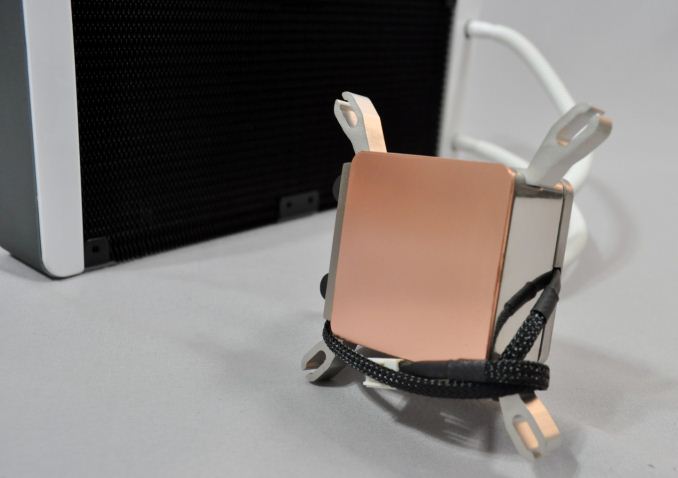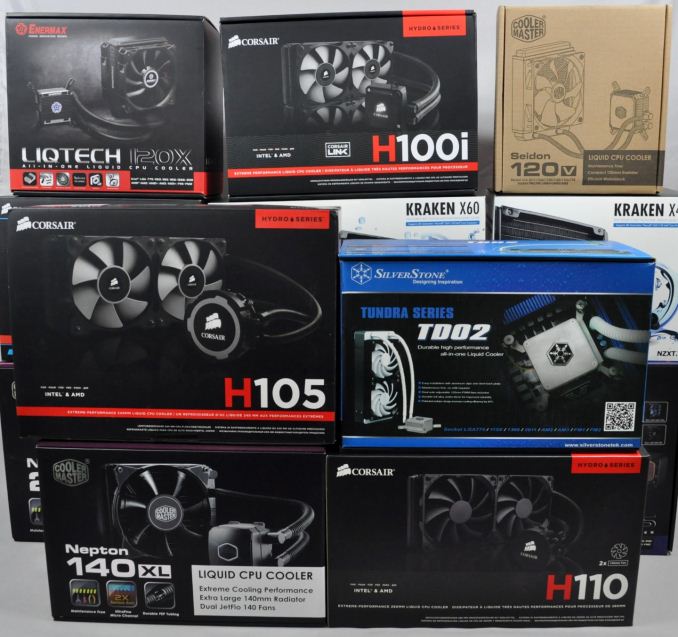Closed Loop AIO Liquid Coolers: 14-way Mega Roundup Review
by E. Fylladitakis on February 12, 2014 7:00 AM EST
Remember the time when liquid cooling a computer chip was considered to be an extreme approach, one performed by hardcore enthusiasts and overclockers alone? Everything had to be personally designed and or procured by the user, as there were no specialized commercial products available at the time. Radiators were modified heater cores extracted from cars, CPU blocks were rare and occasionally machined at local workshops using a copper block and a lathe, while high-performance tubing came from shops with medical supplies.
As demand grew, aided by the ever-increasing noise of small CPU heatsinks, companies specializing on liquid cooling solutions began turning up -- a little too fast perhaps, as tens of companies were founded within a few months' time and very few of them actually survived for more than a couple of years. Enthusiasts could then buy specialized liquid cooling equipment and even whole kits from just one seller and only had to assemble the setup into their system. That of course is no simple process for an amateur and a nightmare for a system builder, who cannot ship a system with a topped off water cooling tank or assume that the user has the skills required to maintain such a system, therefore the potential market remained limited to advanced users only.
This all changed in 2012, when Asetek came up with an inexpensive closed loop solution, a liquid cooling device that was leak-free and required no maintenance at all. The radiators of the first few solutions were small and their overall performance hardly better than that of air coolers; however, aided by the modernization of computer cases, the mounting of larger, thicker radiators inside a PC soon was not a problem. In many cases the kits were now no harder to install than any CPU cooler and required no maintenance at all, opening the market to virtually every computer user seeking a performance cooling solution. This spurred massive interest amongst OEMs and manufacturers, who all strive for a slice of the pie.
There have been tens of AIO (All-in-One) closed loop liquid coolers released just in 2013; today, we are having a roundup with 14 of them, coming from five different manufacturers, alphabetically listed in the table below.
| Product | Radiator Effective Surface | Radiator Thickness | # of Fans (Supplied / Maximum) | Speed Range of Supplied Fans (RPM) | Current Retail Pricing |
| Cooler Master Seidon 120V | 120mm × 120mm | 27mm | 1 / 2 | 600-2400 | $49.99 |
| Cooler Master Nepton 140XL | 140mm × 140mm | 38mm | 2 / 2 | 800-2000 | $99.99 |
| Cooler Master Nepton 280L | 140mm × 280mm | 30mm | 2 / 4 | 800-2000 | $119.99 |
| Corsair H75 | 120mm × 120mm | 25mm | 2 / 2 | 800-2000 | $69.99 |
| Corsair H90 | 140mm × 140mm | 27mm | 1 / 2 | 600-1500 | $84.99 |
| Corsair H100i | 120mm × 240mm | 27mm | 2 / 4 | 800-2700 | $109.99 |
| Corsair H105 | 120mm × 240mm | 38mm | 2 / 4 | 800- 2700 | $119.99 |
| Corsair H110 | 140mm × 280mm | 29mm | 2 / 4 | 600-1500 | $126.99 |
| Enermax Liqmax 120S | 120mm × 120mm | 32mm | 1 / 2 |
600-1300 600-2000 600-2500 (Multi-range) |
$163.00* |
| Enermax Liqtech 120X | 120mm × 120mm | 43mm | 2 / 2 |
600-1300 600-2000 600-2500 (Multi-range) |
$171.10* |
| NZXT Kraken X40 | 140mm × 140mm | 27mm | 1 / 2 | 800-2000 | $89.99 |
| NZXT Kraken X60 | 140mm × 280mm | 27mm | 2 / 4 | 800-2000 | $119.99 |
| Silverstone Tundra TD02 | 120mm × 240mm | 45mm | 2 / 4 | 1500-2500 | $118.99 |
| Silverstone Tundra TD03 | 120mm × 120mm | 45mm | 2 / 2 | 1500-2500 | $97.99 |
*The coolers from Enermax are not widely available in the USA at the time of this review, with the only viable option appearing to be that of import from Asia or Europe.
Although Asetek was the first to come up with the design and they hold patents for it, they are not the only OEM of AIO cooling solutions today. At least three different OEMs are behind the kits listed in the table above. We will have a closer look at each one of them in the following pages.











139 Comments
View All Comments
zodiacfml - Thursday, February 13, 2014 - link
Nice job. I like the various loads given to the coolers. Unfortunately, my interest in liquid coolers becomes less as Intel has been lowering the TDP of their CPUs.prateekprakash - Thursday, February 13, 2014 - link
I only wished they'd included Swiftech's H220 and H320 (Even though they aren't available in the US, but I've have been using H220 in my system here in India)buffhr - Thursday, February 13, 2014 - link
Why wasnt the swiftech H220 included in this list? Would of been really nice to see it stack up against 340W and well it is an AIO and meets up with the same price range as well.Rob94hawk - Sunday, February 16, 2014 - link
Because the H220 is a piece of crap due to mass pump failure. I'm on my 3rd one within warranty and I haven't even put it on yet. I have the stock cooler on my 4770k. That's how much confidence I have in the Swiftech H220.Suuave - Thursday, February 13, 2014 - link
A very interesting article but I have a suggestion of one thing would have definitely made it better - a chart. Give us a simple visual reference of "potential cooling performance" vs "noise level" vs "unit size" vs "price" that would give everyone a quick reference of the overall values for the features they are looking for in a sealed system.vgray35@hotmail.com - Thursday, February 13, 2014 - link
What we sorely need is a table of computer cases with a list of water coolers that fit into each case. A valuable reference that does not exist anywhere as far as I know. The reviewers are in the best position with their knowledge to provide such a table.Hrel - Thursday, February 13, 2014 - link
Would have been great if you guys could have included 1-3 air coolers in this review. For comparison.If you don't overclock and primarily care about noise liquid coolers make no sense at all. My air cooler never exceeds 16db. Apparently 36db is the lowest any of these go. That's simply TERRIBLE.
The PC Apologist - Thursday, February 13, 2014 - link
Would have been great if you read through the comments section...Just saying.
Daeros - Thursday, February 13, 2014 - link
This is really bothering me; this article strongly implies that sound pressure equates linearly to to loudness. The decibel scale is logarithmic, true, but while 3db is roughly a doubling in sound energy, it is the smallest difference reliably discernible as louder by people. It takes roughly a 10db increase in sound pressure to have a doubling in perceived loudness. In the example, the 30db difference would be perceived as (roughly) 8 times louder (3 doublings), not 1000 times louder (even though it may be 1000x as much energy).cactusdog - Friday, February 14, 2014 - link
I don't understand why cooler reviews are done with different speed fans, it makes no sense for comparison.